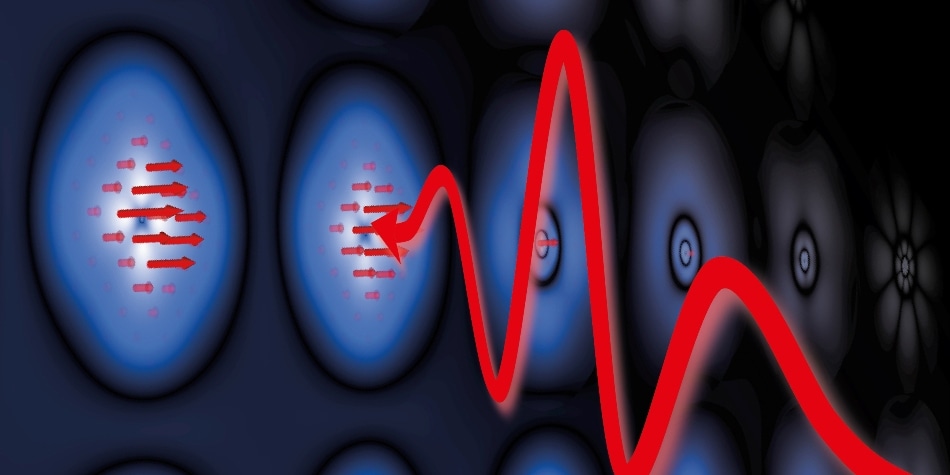Jun 27 2019
For the very first time, physicists have used a light wave within one femtosecond—the fastest magnetic event ever noted, to alter the magnetic moment of a material.
 Recording of the fast switching of magnetic moments by ultrafast light pulses: The red arrows mark the ordered magnetic moment of a layer stack of nickel (ferromagnet) and platinum (metal) before an ultra-short laser pulse inverts the magnetization of the two layers. (Image credit: J.K. Dewhurst)
Recording of the fast switching of magnetic moments by ultrafast light pulses: The red arrows mark the ordered magnetic moment of a layer stack of nickel (ferromagnet) and platinum (metal) before an ultra-short laser pulse inverts the magnetization of the two layers. (Image credit: J.K. Dewhurst)
Absorption of light within one femtosecond (10–15 seconds), which is considered as the limit of the maximum obtainable speed of electronic circuits, has a direct impact on the electronic properties of materials. Conversely, until today, the magnetic moment of matter has only been capable of being affected by a light- and magnetism-linked process and indirectly through magnetic fields. This is the reason behind the extended magnetic switching of about several hundred femtoseconds.
A research team from the Max Planck Institutes for Quantum Optics and for Microstructure Physics, of the Max Born Institute, at the University of Greifswald and Graz University of Technology has manipulated the magnetic properties of a ferromagnetic material on a time scale of electrical field oscillations of visible light—and thus according to the electrical properties—using laser pulses. This effect has been advanced by a factor of 200 and was measured and represented using time-resolved attosecond spectroscopy. The scientists have reported their findings in Nature.
Composition of the Material as an Important Criterion
Magnetic materials—in attosecond spectroscopy—are bombarded with ultra-short laser pulses and are influenced by electronic effect.
According to Martin Schultze, who until recently worked at the Max Planck Institute for Quantum Optics in Munich but is currently a professor at the Institute of Experimental Physics at TU Graz, “The light flashes set off an intrinsic and usually delaying process in the material. The electronic excitation is translated into a change in magnetic properties.”
However, owing to the combination of a ferromagnet with a nonmagnetic metal, the magnetic reaction in the reported experiment can be achieved as quick as the electronic reaction.
By means of the special constellation, we were optically able to bring about a spatial redistribution of the charge carrier, which resulted in a directly linked change in the magnetic properties.
Markus Münzenberg, Professor, Institute of Physics, University of Greifswald
Markus Münzenberg, working with his team in Greifswald, had developed and created the unique material systems.
Schultze was excited about the extent of the success of the research: “Never before has such a fast magnetic phenomenon been observed. Through this, ultrafast magnetism will take on a completely new meaning.”
Sangeeta Sharma, a scientist at the Max Born Institute in Berlin and who anticipated the essential process using computer models, was impressed: “We are expecting a significant development boost from this for all applications in which magnetism and electron spin play a role.”
First Step toward Coherent Magnetism
In addition, the scientists have shown in their measurements that the observed process is coherent: in other words, the quantum mechanical wave nature of the moving charge carriers is maintained. Such conditions permit researchers to use individual atoms as information carriers rather than larger units of material or to influence the varying magnetic properties using another particularly delayed laser pulse, thus leading to technological miniaturization.
“Regarding new perspectives, this could lead to similar fantastic developments as in the field of magnetism, such as electronic coherence in quantum computing,” stated Schultze with hope.
Schultze currently leads a working group concentrating on attosecond physics at the Institute of Experimental Physics.
Development of Top Research at TU Graz
In collaboration with his colleagues at Graz, Schultze wished to expand the institute into a center for ultrafast time-resolved spectroscopy of electronic and magnetic phenomena. As a result, a modern laser laboratory is being constructed at TU Graz’s Campus Neue Technik, which—according to current activities—will continue to improve research in the Field of Expertise “Advanced Materials Science” at TU Graz.